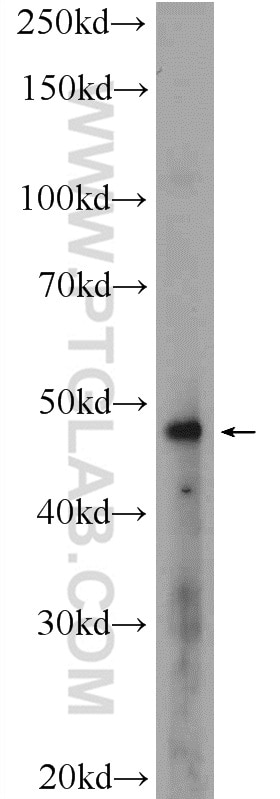RPL5 Polyklonaler Antikörper
RPL5 Polyklonal Antikörper für ELISA
Wirt / Isotyp
Kaninchen / IgG
Getestete Reaktivität
Affe, human, Maus und mehr (1)
Anwendung
WB, PLA, IF, ELISA
Konjugation
Unkonjugiert
Kat-Nr. : 15430-1-AP
Synonyme
Galerie der Validierungsdaten
Geprüfte Anwendungen
Empfohlene Verdünnung
| Anwendung | Verdünnung |
|---|---|
| It is recommended that this reagent should be titrated in each testing system to obtain optimal results. | |
| Sample-dependent, check data in validation data gallery | |
Veröffentlichte Anwendungen
| WB | See 2 publications below |
| IF | See 1 publications below |
Produktinformation
15430-1-AP bindet in WB, PLA, IF, ELISA RPL5 und zeigt Reaktivität mit Affe, human, Maus
| Getestete Reaktivität | Affe, human, Maus |
| In Publikationen genannte Reaktivität | human, Krallenfrosch (Xenopus) |
| Wirt / Isotyp | Kaninchen / IgG |
| Klonalität | Polyklonal |
| Typ | Antikörper |
| Immunogen | RPL5 fusion protein Ag7673 |
| Vollständiger Name | ribosomal protein L5 |
| Berechnetes Molekulargewicht | 34 kDa |
| GenBank-Zugangsnummer | BC001882 |
| Gene symbol | RPL5 |
| Gene ID (NCBI) | 6125 |
| Konjugation | Unkonjugiert |
| Form | Liquid |
| Reinigungsmethode | Antigen-Affinitätsreinigung |
| Lagerungspuffer | PBS mit 0.02% Natriumazid und 50% Glycerin pH 7.3. |
| Lagerungsbedingungen | Bei -20°C lagern. Nach dem Versand ein Jahr lang stabil Aliquotieren ist bei -20oC Lagerung nicht notwendig. 20ul Größen enthalten 0,1% BSA. |
Hintergrundinformationen
The mammalian ribosome is a macromolecular assembly of 4 RNA species (rRNAs) and approximately 80 different proteins, including RPL5. RPL5 (ribosome protein L15) is rquired for rRNA maturation and formation of the 60S ribosomal subunits, and defects or mutation in RPL5 is the cause of DBA6.
Publikationen
| Species | Application | Title |
|---|---|---|
Sci Adv Genomic gain of RRS1 promotes hepatocellular carcinoma through reducing the RPL11-MDM2-p53 signaling. | ||
J Cell Biol Phase separation and toxicity of C9orf72 poly(PR) depends on alternate distribution of arginine. | ||
Elife Receptor-specific interactome as a hub for rapid cue-induced selective translation in axons. | ||
Cell Signal Interleukin-6 influences stress-signalling by reducing the expression of the mTOR-inhibitor REDD1 in a STAT3-dependent manner. | ||
Open Biol ESCRT-II controls retinal axon growth by regulating DCC receptor levels and local protein synthesis. |



